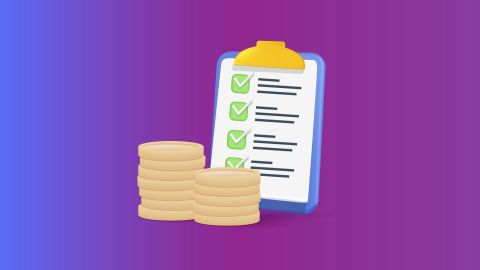बिज़नेस की कार्यशील पूंजी शॉर्ट-टर्म लिक्विडिटी या अपने शॉर्ट-टर्म खर्चों को पूरा करने की क्षमता को दर्शाती है और इस प्रकार इसकी ऑपरेशनल दक्षता को दर्शाती है. इसलिए, सुनिश्चित करें कि आप कार्यशील पूंजी की गणना को प्राथमिकता दें. यह आपको अपनी कंपनी की लिक्विडिटी स्टैंडिंग की सटीक तस्वीर देगा और ध्यान देने की आवश्यकता वाले किसी भी क्षेत्र को हाइलाइट करेगा.
कार्यशील पूंजी गणना फॉर्मूला
हालांकि आप अपने बिज़नेस के लिए विभिन्न तरीकों से कार्यशील पूंजी की गणना कर सकते हैं, लेकिन अधिकांश कंपनियां नेट कार्यशील पूंजी के रूप में अपने बिज़नेस को व्यक्त करना पसंद करती हैं. निवल कार्यशील पूंजी की गणना में आपके बिज़नेस की मौजूदा एसेट से मौजूदा देयताओं की कटौती शामिल है.
वर्तमान एसेट लिक्विड एसेट हैं जिन्हें एक वर्ष के भीतर कैश में बदला जा सकता है. इनमें देनदार या प्राप्त होने वाले अकाउंट, एडवांस में भुगतान किए गए खर्च (प्रीपेड खर्च), हाथ में कैश, बैंक में कैश, साथ ही बेची गई इन्वेंटरी, वर्क-इन-प्रोग्रेस करने वाले सामान और कच्चे माल शामिल हैं. दूसरी ओर, वर्तमान देयताएं एक बिज़नेस द्वारा इसके संचालन में किए गए दैनिक कर्ज़ हैं. ये वेंडर (देय किए जाने वाले अकाउंट या लेनदार) से की गई क्रेडिट खरीद, ऐसे खर्च हो सकते हैं जिन्हें अभी तक (बाकी खर्च) के लिए भुगतान नहीं किया गया है, आदि.
कार्यशील पूंजी की गणना करते समय, निम्नलिखित एडजस्टमेंट करनी होगी:
- कैश इन हैंड कैश से कैश प्रतिबद्धता काट लें: शेयरों का बायबैक, घोषित लाभांश आदि.
- देनदारों से गैर-व्यापार प्राप्तियों को हटाएं: कर्मचारियों को लोन.
- कुल इन्वेंटरी से पुराने, बर्बाद और अप्रचलित स्टॉक को घटाएं.
कार्यशील पूंजी की गणना: एक उदाहरण
मान लें कि आपके बिज़नेस में वर्तमान एसेट और देयताओं की लिस्ट नीचे दी गई है:
वर्तमान एसेट |
राशि (₹) |
वर्तमान देयता |
राशि (₹) |
देनदार |
₹1.45 लाख |
लेनदार |
₹2.4 लाख |
बेचे गए इन्वेंटरी |
₹ 30,000 |
बकाया खर्च |
₹ 25,000 |
कच्चा माल |
₹ 10,000 |
|
|
ऑब्सोलेट स्टॉक |
₹ 4,000 |
|
|
हाथ में कैश |
₹ 20,000 |
|
|
प्रीपेड खर्च |
₹ 1,000 |
|
|
कुल |
₹2.10 लाख |
कुल |
₹2.65 लाख |
कार्यशील पूंजी = वर्तमान एसेट - वर्तमान देयताएं
कार्यशील पूंजी = ₹2.10 लाख - ₹2.65 लाख
इसलिए, आपकी कंपनी की कार्यशील पूंजी = - ₹. 55,000
कार्यशील पूंजी संकेत
कार्यशील पूंजी मैनेजमेंट के परिणामस्वरूप वर्तमान एसेट वर्तमान देयताओं से अधिक हो जाएंगे. इसलिए, अगर यह 1.2 से 2 की रेंज के भीतर है, तो आपके बिज़नेस के कार्यशील पूंजी अनुपात को स्वस्थ माना जाता है.
- पॉजिटिव नेट वर्किंग कैपिटल यह दर्शाता है कि आपकी शॉर्ट-टर्म बिज़नेस आवश्यकताओं को पूरा किया जा रहा है.
- अगर आपकी निवल कार्यशील पूंजी शून्य है, तो इसका मतलब है कि आपकी कंपनी के पास अपनी शॉर्ट-टर्म देयताओं का भुगतान करने के लिए पर्याप्त राशि है.
- नकारात्मक निवल कार्यशील पूंजी का अर्थ है कि कंपनी को अपने मौजूदा कर्ज़ को पूरा करने के लिए अधिक कर्ज़ की आवश्यकता.
अपने कार्यशील पूंजी अनुपात की निगरानी करें और कुशल कार्यशील पूंजी मैनेजमेंट के लिए कम कलेक्शन अवधि और इन्वेंटरी टर्नओवर रेशियो सुनिश्चित करें.
अगले चरण
अगर आपके बिज़नेस की निवल कार्यशील पूंजी नकारात्मक है, तो यह आपके दैनिक कार्यों को बाधित कर सकता है और बिज़नेस के अवसरों को छोड़ सकता है. ऐसे मामले में, आपको घाटे को फाइनेंस करना चाहिए और एक अच्छी कार्यशील पूंजी मैनेजमेंट पॉलिसी होनी चाहिए ताकि आपका बिज़नेस बिना किसी देरी या गड़बड़ी के आसानी से काम कर सके.
कार्यशील पूंजी नीति को संशोधित करें
नकारात्मक कार्यशील पूंजी को विभिन्न तरीकों से मैनेज किया जा सकता है. उदाहरण के लिए, आप कंपनी के खर्चों को कम कर सकते हैं और यह सुनिश्चित कर सकते हैं कि आपकी कलेक्शन की शर्तें टाइट हो और डेबिट साइड पर पालन की जाए. क्रेडिट के सामने, आप भुगतान विंडो को बढ़ाने के लिए अपने आपूर्तिकर्ताओं से संपर्क कर सकते हैं.
कार्यशील पूंजी लोन के साथ घाटे को फंड करें
अपनी ऑपरेटिंग कैपिटल को तुरंत बढ़ावा देने के लिए, आप कार्यशील पूंजी लोन पर विचार कर सकते हैं. बजाज फिनसर्व का कार्यशील पूंजी लोन आपको किसी भी लिक्विडिटी अंतर को तुरंत पूरा करने की अनुमति देगा क्योंकि यह केवल 24 घंटों में अप्रूवल के साथ ₹ 80 लाख तक का फंड प्रदान करता है.
इसका मतलब यह है कि आप जल्द से जल्द इस स्थिति से निपटा सकते हैं, जिससे आपके उद्यम के संचालन को और नुकसान से बचा जा सकता है. इसके अलावा, आप फ्लेक्सी फॉर्मेट में इस लोन का लाभ उठा सकते हैं ताकि आप घाटे के अनुसार उधार ले सकें और जब आपको देनदारों से पैसे प्राप्त होते हैं तो प्री-पे कर सकें. यहां, आप केवल उपयोग की गई राशि पर ब्याज का भुगतान करते हैं न कि पूरी राशि पर. आपको EMIs के रूप में केवल ब्याज का भुगतान करने का विकल्प भी मिलता है, जिससे लिक्विडिटी की कमी और भी आसान हो जाती है. यह यूनीक सुविधा इन लोन को अनियोजित कार्यशील पूंजी या कैश फ्लो आवश्यकताओं को मैनेज करने के लिए सर्वश्रेष्ठ बनाती है.
अस्वीकरण:
हांलाकि यहां शामिल या उपलब्ध जानकारी, प्रोडक्ट और सेवाओं को अपडेट करने में सावधानी बरती जाती है हमारी वेबसाइट और संबंधित प्लेटफॉर्म/वेबसाइट, जानकारी को अपडेट करने में अनुचित गलतियां या टाइपोग्राफिकल एरर या देरी हो सकती है. इस साइट और संबंधित वेबपेजों में शामिल सामग्री संदर्भ और सामान्य जानकारी के उद्देश्य के लिए है और किसी भी असंगति की स्थिति में संबंधित प्रोडक्ट/सेवा डॉक्यूमेंट में उल्लिखित विवरण का पालन किया जाएगा. सब्सक्राइबर्स और यूज़र्स को यहां दी गई जानकारी के आधार पर आगे बढ़ने से पहले प्रोफेशनल सलाह लेनी चाहिए. कृपया संबंधित प्रोडक्ट/सेवा डॉक्यूमेंट और लागू नियमों और शर्तों को पढ़ने के बाद ही किसी भी प्रोडक्ट या सेवा के बारे में सोच-समझकर निर्णय लें. अगर कोई विसंगति दिखाई देती है, तो कृपया यहां क्लिक करें संपर्क जानकारी.
*नियम व शर्तें लागू








